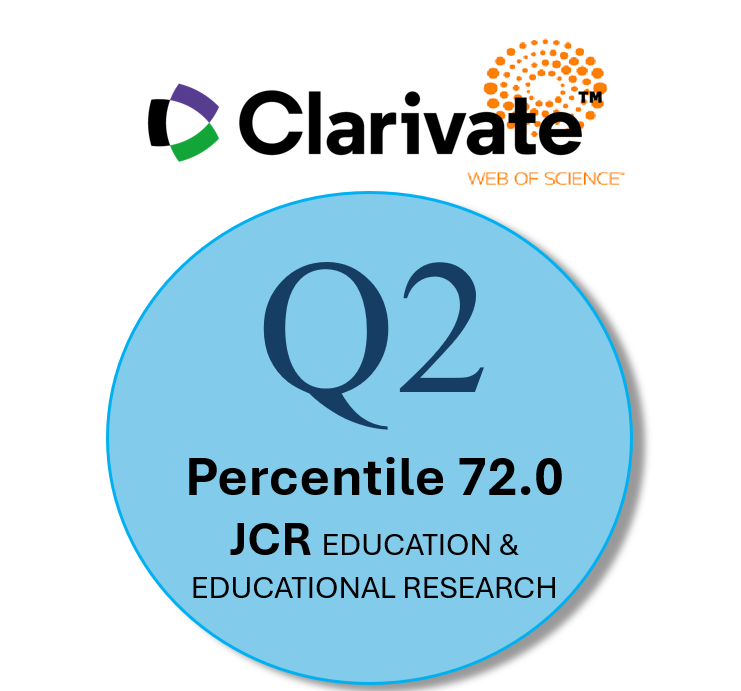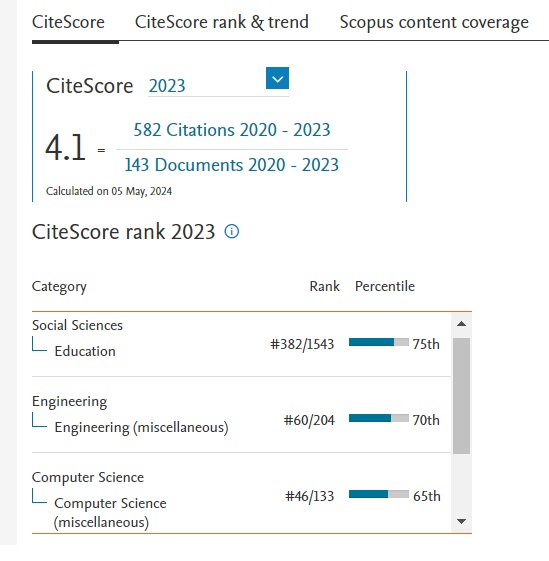Los docentes y las redes sociales: Usos y motivaciones
Agencias de apoyo
- Esta publicación es parte del proyecto de I D i PGC2018-096474-B-I00, financiado/a por MCIN/ AEI/10.13039/501100011033/ “FEDER Una manera de hacer Europa”
Resumen
Las redes sociales propician oportunidades de aprendizaje informal que los docentes utilizan para su desarrollo profesional. Mediante el análisis de datos recogidos a través de un cuestionario respondido por 447 docentes hemos conocido cuáles son las redes sociales que más utilizan para su aprendizaje, qué diferencias existen en el uso de estas y cuáles son los motivos que los lleva a utilizarlas para su labor docente. Al abordar las redes sociales que más se utilizan, se han realizado contrastes de diferencias de medias considerando las variables nominales de sexo, edad y nivel educativo en el que se enseña. Encontramos que los docentes se motivan para utilizar las redes sociales en la medida en que suponen un espacio para encontrar recursos digitales, materiales, videotutoriales elaborados por otros docentes y que pueden considerar se interés. Sin embargo, los docentes no suelen recurrir a las redes sociales para superar el aislamiento que puedan sentir, ni para compartir preocupaciones o emociones ni para pedir ayuda a otro compañero. En futuras investigaciones será necesario indagar acerca de en qué medida la participación de los docentes en las redes sociales repercute en la mejora de la práctica docente y en los aprendizajes de los estudiantes
Descargas
-
Resumen5854
-
PDF5535
Citas
Ab Rashid, R., Yahaya, M. F., Rahman, M. F. A. & Yunus, K. (2016). Teachers’ Informal Learning via Social Networking Technology. International Journal of Emerging Technologies in Learning, 11(10), 76–79. https://doi.org/10.3991/ijet.v11i10.5908
Autores. (2021).
Carpenter, J. P., & Krutka, D. G. (2014). How and why educators use Twitter: A survey of the field. Journal of Research on Technology in Education, 46(4), 414-434. https://doi.org/10.1080/15391523.2014.925701
Carpenter, J. P., Morrison, S. A., Craft, M., & Lee, M. (2020). How and why are educators using Instagram? Teaching and teacher education, 96, 103149. https://doi.org/10.1016/j.tate.2020.103149
Carpenter, J., Tani, T., Morrison, S., & Keane, J. (2020). Exploring the landscape of educator professional activity on Twitter: An analysis of 16 education-related Twitter hashtags. Professional Development in Education, 1-22. https://doi.org/10.1080/19415257.2020.1752287
Cruz Pichardo, I. M. (2016). Percepciones en el uso de las redes sociales y su aplicación en la enseñanza de las matemáticas. Pixel-Bit: Revista de Medios y Educación, 48, 165-186. https://doi.org/10.12795/pixelbit.2016.i48.11
De Rijdt, C., Stes, A., van der Vleuten, C., & Dochy, F. (2013). Influencing variables and moderators of transfer of learning to the workplace within the area of staff development in higher education: Research review. Educational Research Review, 8, 48–74. https://doi.org/10.1016/j.edurev.2012.05.007
Del-Fresno-García, M., Daly, A., & Segado-Sánchez-Cabezudo, S. (2016). Identificando a los nuevos influyentes en tiempos de Internet: Medios sociales y análisis de redes sociales / Identifying the new Influencers in the Internet Era: Social Media and Social Network Analysis. Revista Española de Investigaciones Sociológicas, 153, 23-40. https://doi.org/10.5477/cis/reis.153.23
Dille, K. B., & Røkenes, F. M. (2021). Teachers’ professional development in formal online communities: A scoping review. Teaching and Teacher Education, 105, 103431. https://doi.org/https://doi.org/10.1016/j.tate.2021.103431
Donelan, H. (2016). Social media for professional development and networking opportunities in academia. Journal of Further and Higher Education, 40(5), 706–729. https://doi.org/10.1080/0309877X.2015.1014321
Fox, A. R. C., & Wilson, E. G. (2015). Networking and the development of professionals: Beginning teachers building social capital. Teaching and Teacher Education, 47, 93–107. https://doi.org/10.1016/j.tate.2014.12.004
Gee, J. (2005). Semiotic social spaces and affinity spaces: From The Age of Mythology to today's schools. In D. Barton & K. Tusting (Eds.), Beyond Communities of Practice: Language Power and Social Context (Learning in Doing: Social, Cognitive and Computational Perspectives, pp. 214-232). Cambridge: Cambridge University Press. https://doi:10.1017/CBO9780511610554.012
Gilbert, S. (2016). Learning in a Twitter-based community of practice: an exploration of knowledge exchange as a motivation for participation in #hcsmca. Information, Communication & Society, 19(9), 1214–1232. https://doi.org/10.1080/1369118X.2016.1186715
Goodyear, V., Parker, M. & Casey, A. (2019). Social media and teacher professional learning communities. Physical Education and Sport Pedagogy, 24(5), 421-433. https://doi.org/10.1080/17408989.2019.1617263
Greenhalgh, S. P., Rosenberg, J. M., & Russell, A. (2021). The influence of policy and context on teachers’ social media use. British Journal of Educational Technology, 52, 2020–2037. https://doi.org/10.1111/bjet.13096
Greenhalgh, S., Rosenberg, J., & Wolf, L. (2016). For all intents and purposes: Twitter as a foundational technology for teachers. E-Learning and Digital Media, 13, 81-98. https://doi.org/10.1177/2042753016672131
Greenhow, C., & Askari, E. (2017). Learning and teaching with social network sites: A decade of research in K-12 related education. Education and Information Technologies, 22(2), 623–645. https://doi.org/10.1007/s10639-015-9446-9
Hart, J. E., & Steinbrecher, T. (2011). Omg! Exploring and learning from teachers’ personal and professional uses of Facebook. Action in Teacher Education, 33(4), 320-328. https://doi.org/10.1080/01626620.2011.620515
Higueras-Rodríguez, L., Medina-García, M., & Pegalajar-Palomino, M. D. (2020). Use of Twitter as an Educational Resource. Analysis of Concepts of Active and Trainee Teachers. In Education Sciences. 10, (8). https://doi.org/10.3390/educsci10080200
Holmes, K., Preston, G., Shaw, K., & Buchanan, R. (2013). ‘Follow’ Me: Networked Professional Learning for Teachers. Australian Journal of Teacher Education, 38(12). https://doi.org/10.14221/ajte.2013v38n12.4
Jones, W. M., Dexter, S., Jones, W. M., & Dexter, S. (2014). How teachers learn: the roles of formal, informal, and independent learning. Educational Technology Research Development, 62(3), 367–384. https://doi.org/10.1007/s11423-014-9337-6
Kamalodeen, V. J. & Jameson-Charles, M. (2016). A Mixed Methods Research Approach to Exploring Teacher Participation in an Online Social Networking Website. International Journal of Qualitative Methods, 1-14. https://10.1177/1609406915624578
Kennedy, M. M. (2019). How We Learn About Teacher Learning. Review of Research in Education, 43(1), 138–162. https://doi.org/10.3102/0091732X19838970
Kyndt, E., Gijbels, D., Grosemans, I., & Donche, V. (2016). Teachers’ Everyday Professional Development: Mapping Informal Learning Activities, Antecedents, and Learning Outcomes. Review of Educational Research, 86(4), 1111–1150. https://doi.org/10.3102/0034654315627864
Lantz-Andersson, A., Lundin, M., & Selwyn, N. (2018). Twenty years of online teacher communities: A systematic review of formally-organized and informally-developed professional learning groups. Teaching and Teacher Education, 75, 302–315. https://doi.org/https://doi.org/10.1016/j.tate.2018.07.008
Lazarsfeld, P. F., Berelson, B., & Gaudet, H. (1948). The people’s choice: How the voter makes up his mind in a presidential campaign. Columbia University Press
Li, S., Zheng, J., & Zheng, Y. (2020). Towards a new approach to managing teacher online learning: Learning communities as activity systems. The Social Science Journal, 1–13. https://doi.org/10.1016/j.soscij.2019.04.008
Loughran, John, & Hamilton, L. (2016). Developing and Understanding of teacher Education. In J. Loughran & M. L. Hamilton (Eds.), International Handbook of Teacher Education (pp. 3–22). Springer.
Luo, T., Freeman, C., & Stefaniak, J. (2020). “Like, comment, and share”—professional development through social media in higher education: A systematic review. Educational Technology Research and Development, 68(4), 1659–1683. https://doi.org/10.1007/s11423-020-09790-5
Macià, M., & García, I. (2016). Informal online communities and networks as a source of teacher professional development: A review. Teaching and Teacher Education, 55, 291–307. https://doi.org/https://doi.org/10.1016/j.tate.2016.01.021
Malik, A., Heyman-Schrum, C., & Johri, A. (2019). Use of Twitter across educational settings: a review of the literature. International Journal of Educational Technology in Higher Education, 16(1), 36. https://doi.org/10.1186/s41239-019-0166-x
Newton, J.R & Williams, M.C (2021). Instagram as a Special Educator Professional Development Tool: A Guide to Teachergram. Journal of Special Education Technology. https://doi.org/10.1177%2F01626434211033596
Nochumson, T. (2018). An investigation of elementary schoolteachers’ use of twitter for their professional learning. Columbia University.
Nochumson, T. C. (2020). Elementary schoolteachers’ use of Twitter: exploring the implications of learning through online social media. Professional Development in Education, 46(2), 306–323. https://doi.org/10.1080/19415257.2019.1585382
Owen, N., Fox, A. & Bird, T (2016). The development of a small-scale survey instrument of UK teachers to study professional use (and non-use) of and attitudes to social media. International Journal of Research & Method in Education, 39(2), 170–193. https://doi.org/10.1080/1743727X.2015.1041491
Prestridge, S. (2019). Categorising teachers’ use of social media for their professional learning: A self-generating professional learning paradigm. Computers & Education, 129, 143-158. https://doi.org/10.1016/j.compedu.2018.11.003
Rehm, M., & Notten, A. (2016). Twitter as an informal learning space for teachers!? The role of social capital in Twitter conversations among teachers. Teaching and Teacher Education, 60, 215–223. https://doi.org/https://doi.org/10.1016/j.tate.2016.08.015
Rodríguez-Gallego, M., López Martínez, A., & Martín Herrera, I. (2017). Percepciones de los estudiantes de Ciencias de la Educación sobre las redes sociales como metodología didáctica. Pixel-Bit. Revista De Medios Y Educación, 50, 77-93. Recuperado a partir de https://recyt.fecyt.es/index.php/pixel/article/view/61766
Russ, R. S., Sherin, B. L., & Gamoran, M. (2016). What constitutes teacher learning? In D. H. Gitomer & C. A. Bell (Eds.), Handbook of Research on Teaching (pp. 391–438). American Educational Research Association. https://www.scholars.northwestern.edu/en/publications/what-constitutes-teacher-learning
Scholastic (2014). Primary sources: America’s teachers on teaching in an era of change. (3rd ed.) Bill and Melissa Gates Foundation. Retrieved from http://bit.ly/1UE5YRT
Shelton, C., Curcio, R. & Schroeder, S. (2020). Instagramming their Hearts Out: Teacher Influencers on Instagram. In D. Schmidt-Crawford (Ed.), Proceedings of Society for Information Technology & Teacher Education International Conference (pp. 1486-1492). Online: Association for the Advancement of Computing in Education (AACE). Retrieved December 2, 2021 from https://www.learntechlib.org/primary/p/215915/.
Staudt Willet, K. B. (2019). Revisiting How and Why Educators Use Twitter: Tweet Types and Purposes in #Edchat. Journal of Research on Technology in Education, 51(3), 273–289. https://doi.org/10.1080/15391523.2019.1611507
Tang, Y. & Hew, K.F. (2017). Using Twitter for education: Beneficial o simply a waste of time? Computers & Education, 106, 97-118. https://doi.org/10.1016/j.compedu.2016.12.004
Tess, P. A. (2013). The role of social media in higher education classes (real and virtual). A literature review. Computers in Human Behavior, 29 (5), A60 A68. http://dx.doi.org/10.1016/j.chb.2012.12.032
Theocharis, Y., Lowe, W., Van Deth, J. W., & García-Albacete, G. (2015). Using Twitter to mobilize protest action: online mobilization patterns and action repertoires in the Occupy Wall Street, Indignados, and Aganaktismenoi movements. Information, Communication & Society, 18(2), 202-220. https://doi.org/10.1080/1369118X.2014.948035
Túñez López, M., & Sixto García, J. (2012). Las redes sociales como entorno docente: análisis del uso de Facebook en la docencia universitaria. Pixel-Bit. Revista De Medios Y Educación, 41, 77-92. Recuperado a partir de https://recyt.fecyt.es/index.php/pixel/article/view/61591
van den Beemt, A., Ketelaar, E., Diepstraten, I. & de Laat, M. (2018). Teachers’ motives for learning in networks: costs, rewards and community interest. Educational Research, 60(1), 31-46. https://doi.org/10.1080/00131881.2018.1426391
Wideen, M., Mayer-Smith, J., & Moon, B. (1998). A critical analysis of the research on learning to teach: Making the case for an ecological perspective on inquiry. Review of Educational Research, 68, 130–178. https://doi.org/10.2307/1170752
Xing, W., & Gao, F. (2018). Exploring the relationship between online discourse and commitment in Twitter professional learning communities. Computers & Education, 126, 388–398. https://doi.org/https://doi.org/10.1016/j.compedu.2018.08.010
Derechos de autor 2023 Revista de Educación a Distancia (RED)

Esta obra está bajo una licencia internacional Creative Commons Atribución-NoComercial 4.0.
Las obras que se publican en esta revista están sujetas a los siguientes términos:
1. El Servicio de Publicaciones de la Universidad de Murcia (la editorial) conserva los derechos patrimoniales (copyright) de las obras publicadas, y favorece y permite la reutilización de las mismas bajo la licencia de uso indicada en el punto 2.
2. Las obras se publican en la edición electrónica de la revista bajo una licencia Creative Commons Reconocimiento-NoComercial-SinObraDerivada 3.0 España (texto legal). Se pueden copiar, usar, difundir, transmitir y exponer públicamente, siempre que: i) se cite la autoría y la fuente original de su publicación (revista, editorial y URL de la obra); ii) no se usen para fines comerciales; iii) se mencione la existencia y especificaciones de esta licencia de uso.
3. Condiciones de auto-archivo. Se permite y se anima a los autores a difundir electrónicamente las versiones pre-print (versión antes de ser evaluada) y/o post-print (versión evaluada y aceptada para su publicación) de sus obras antes de su publicación, ya que favorece su circulación y difusión más temprana y con ello un posible aumento en su citación y alcance entre la comunidad académica. Color RoMEO: verde.














